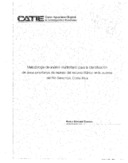| dc.contributor.author | Sánchez Campos, Karla | |
| dc.date.accessioned | 2014-10-18T02:23:37Z | |
| dc.date.available | 2014-10-18T02:23:37Z | |
| dc.date.issued | 2002 | es_ES |
| dc.identifier | 365629 | es_ES |
| dc.identifier.uri | https://repositorio.catie.ac.cr/handle/11554/3193 | |
| dc.description | Tesis (Mag. Sc.) -- CATIE, 2002 | es_ES |
| dc.description | 149 páginas | |
| dc.description | 17 ilus. 18 tab. Mapas | |
| dc.description | Referencias 116-123 | |
| dc.description.abstract | El objetivo de la presente investigación fue desarrollar una metodología de análisis multicriterio que utilice Sistemas de Información Geográfica (SIG) para la identificación de áreas prioritarias de manejo del recurso hídrico en la cuenca del Río Sarapiquí, Costa Rica, con el fin de aportar elementos que ayuden a la conservación del agua, utilizada ampliamente en esta cuenca para fines hidroenergéticos, consumo humano y turísticos, entre otros. La metodología consistió de varias etapas, iniciando con una caracterización biofísica y antropogénica de la cuenca y la creación y validación de una base de datos digital. Se identificaron y caracterizaron los principales usuarios del recurso hídrico (consumo humano, sistemas agropecuarios, transportistas fluviales, actividades turísticas y Producción hidroenergética) a nivel espacial y temporal. Los resultados del modelo de priorización de áreas de manejo de la cantidad aprovechable del agua, muestran una predominancia de áreas catalogadas como de Mediana y de Baja prioridad con proridad 65,3 por ciento y 33,0 por ciento respectivamente. | es_ES |
| dc.description.abstract | This research focuses on the development of a Multicriteria Analysis Methodology with Geographic Information System (GIS) to identify priority areas for management of water resources in Sarapiquí River watershed, Costa Rica, in order to support initiatives for the enhancement of water conservation, a very important resource of this watershed for hydroelectric production, human consumption and tourism. The method has the following step-by-step procedures initiating with a anthropogenic and biophysical characterization of the watershed, followed by the development and validation of a digital data base. Main users of water resources were identified (human consumption, livestock systeMON, fluvial navigators, tourism and hydroelectric production) in spatial and temporary levels. The priority model used in water quantity management showed predominance of areas catalogued in Medium and Low priority classes, with values of 65,3 percent and 33,0 percent of total area, respectively. | |
| dc.language.iso | es | es_ES |
| dc.publisher | CATIE, Turrialba (Costa Rica) | es_ES |
| dc.relation.ispartof | Maestría en Manejo y Gestión en Cuencas Hidrográficas | |
| dc.subject | WATER RESOURCES | |
| dc.subject | WATERSHEDS | |
| dc.subject | WATER MANAGEMENT | |
| dc.subject | CLIMATIC FACTORS | |
| dc.subject | VEGETATION | |
| dc.subject | LAND USE | |
| dc.subject | RESOURCE MANAGEMENT | |
| dc.subject | RESOURCE CONSERVATION | |
| dc.subject | SOCIOECONOMIC DEVELOPMENT | |
| dc.subject | PLANNINGCOSTA RICA | |
| dc.subject | RECURSOS HIDRICOS | |
| dc.subject | CUENCAS HIDROGRAFICAS | |
| dc.subject | ORDENACION DE AGUAS | |
| dc.subject | FACTORES CLIMATICOS | |
| dc.subject | VEGETACION | |
| dc.subject | UTILIZACION DE LA TIERRA | |
| dc.subject | CONSERVACION DE LOS RECURSOS | |
| dc.subject | DESARROLLO ECONOMICO Y SOCIAL | |
| dc.subject | PLANIFICACION | |
| dc.title | Metodología de análisis multicriterio para la identificación de áreas prioritarias de manejo del recurso hídrico en la cuenca del Río Sarapiquí, Costa Rica | es_ES |
| dc.title.alternative | Multicriteria analysis methodology for the identification of priority areas for water resources management in Sarapiquí River watershed, Costa Rica. | es_ES |
| dc.type | Tesis de maestría | es_ES |
| dcterms.rights | acceso abierto | es_Es |
| dc.identifier.publication | Turrialba (Costa Rica) | es_ES |


